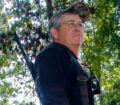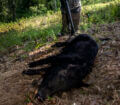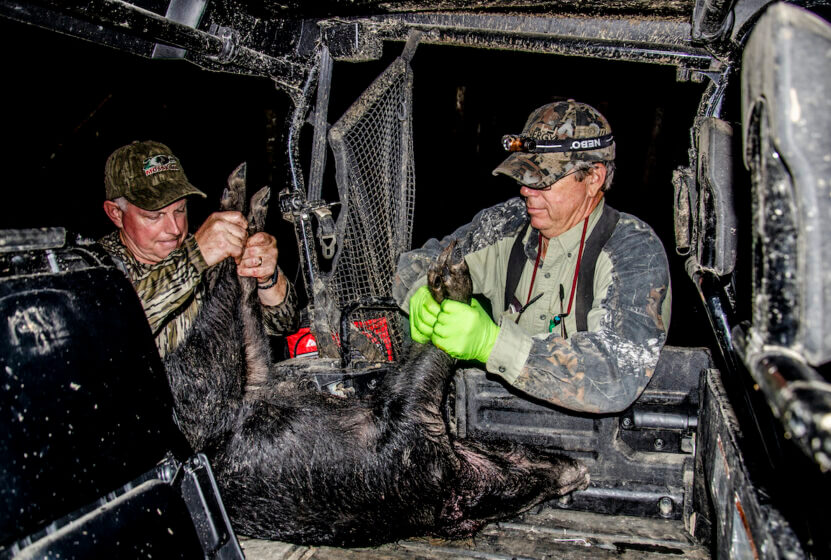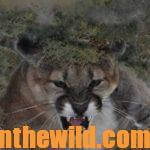Editor’s Note: Biologists name feral hogs and their high-reproductive rate as the worst critters in the woods for destroying ground-nesting birds’ nests, like grouse, bobwhite quail and turkeys, eating their eggs, outcompeting deer for natural food, besides destroying crops, rooting-up green fields, eating supplemental feed intended for deer and turkeys, rooting-up roads, killing newborn fawns, threatening wetlands’ habitat and destroying ecosystems.
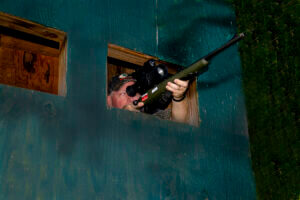 I went to the McKenna Ranch with Michael Jones, the Program Manager for Outdoors for Visit Mississippi, who explained, “Mark McKenna had called me and asked me to bring in some writers to hunt hogs at night to make more people aware of the hog problem in his section of Mississippi and to give hunters an opportunity to hunt hogs at night. After a short conversation with Mark, I learned that, like many places around Mississippi, he had a really-serious hog problem on his land and needed some help getting rid of those hogs. I never had hunted hogs at night using night-vision and thermal binocular and monocular before.
I went to the McKenna Ranch with Michael Jones, the Program Manager for Outdoors for Visit Mississippi, who explained, “Mark McKenna had called me and asked me to bring in some writers to hunt hogs at night to make more people aware of the hog problem in his section of Mississippi and to give hunters an opportunity to hunt hogs at night. After a short conversation with Mark, I learned that, like many places around Mississippi, he had a really-serious hog problem on his land and needed some help getting rid of those hogs. I never had hunted hogs at night using night-vision and thermal binocular and monocular before.
“Something that really surprised me was when the hogs came in to the feeder, we couldn’t hear them at all. They came in totally silent, and we never would have seen them without the thermal monocular. We would scan the area with the monocular, and once we identified a hog, then I’d use the night-vision riflescope to look at the hog and wait for it to turn broadside to me before I took the shot. Mark McKenna had instructed us to shoot for the heads of the hogs. By taking that shot, we shouldn’t have to trail the hogs after the shot through thick cover. You also wouldn’t ruin any of that delicious all-natural hog meat that way.”
So, Jones aimed for the thick part of the neck right behind the hog’s head to drop the hog in his tracks. “The first hog that came in was headed for the feeder, and I missed him,” Jones recalls. Two hogs were going toward the feeder – one black and the other brown. After Jones missed the first hog, both hogs came back in to the feeder. This time, Jones was dead-on and dropped the hog. I really thought that hunting at night with night-vision and a thermal monocular was a neat way to hunt.
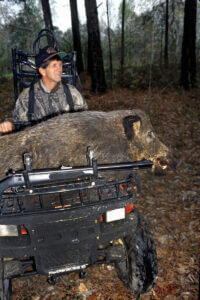 “When we went to retrieve my hog, we recovered the black hog first, and then as we were starting to leave, I found the brown hog that I thought I missed but didn’t,” Jones says. “Both hogs would weigh between 50-60 pounds each – just right for table fare. I was surprised at how lean the meat was and can’t wait to get home and cook it.”
“When we went to retrieve my hog, we recovered the black hog first, and then as we were starting to leave, I found the brown hog that I thought I missed but didn’t,” Jones says. “Both hogs would weigh between 50-60 pounds each – just right for table fare. I was surprised at how lean the meat was and can’t wait to get home and cook it.”
(Note: When cooked, feral hogs need to reach an internal temperature of 160-165 degrees to eliminate the risk of Trichinosis, a food-borne disease caused by a microscopic parasite Trichinella. You’ll need a meat thermometer on hand to ensure the meat reaches the correct temperature).
“Hogs have become a real nuisance in Mississippi and many areas.” Jones says. “They’re not only a detriment to wildlife, they’re destroying crops and rooting-up green fields planted for wildlife. Like many other sections of the South, our native wildlife is a cash crop for many of our landowners who raise timber, as well as row crops and animals. Much of Mississippi’s land is leased out for hunting, and the state has a number of lodges. So, feral hogs have had a negative impact on our agriculture, and for many landowners like Mark McKenna and his family, we’re glad to see that some of the landowners are offering hog hunts to the public for a fee. We also have some public land where hunters can hunt hogs and get pork tenderloin, ham, bacon and shoulders for nearly nothing. If you cook wild hog properly, they can provide some of the most-delicious meat you’ll ever want to eat.”
 To learn more about hog hunting in Mississippi, check the Department of Wildlife, Fisheries and Parks website https://www.mdwfp.com/wildlife-hunting/wild-hog-program/ for rules and regulations on hunting wild hogs, or check the Department of Agriculture and Commerce website https://www.mdac.ms.gov/whcp/ for information on the Wild Hog Control Program (where you can find out how to apply/if you qualify to receive traps being offered to land managers for the control of wild hogs on private agricultural and forestry lands in Mississippi). You can also contact Mike Jones at [email protected] or go to https://visitmississippi.org.
To learn more about hog hunting in Mississippi, check the Department of Wildlife, Fisheries and Parks website https://www.mdwfp.com/wildlife-hunting/wild-hog-program/ for rules and regulations on hunting wild hogs, or check the Department of Agriculture and Commerce website https://www.mdac.ms.gov/whcp/ for information on the Wild Hog Control Program (where you can find out how to apply/if you qualify to receive traps being offered to land managers for the control of wild hogs on private agricultural and forestry lands in Mississippi). You can also contact Mike Jones at [email protected] or go to https://visitmississippi.org.
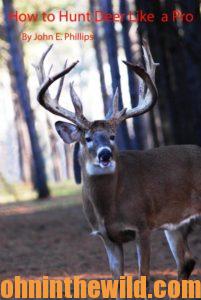 To learn more about hunting deer, check out John E. Phillips’ book, “How to Hunt Deer Like a Pro,” available in Kindle, print and Audible versions at (http://amzn.to/YpoQHA). You may have to copy and paste this link into your browser. (When you click on this book, notice on the left where Amazon says you can read 10% of the book for free, and you can hear 10% for free).
To learn more about hunting deer, check out John E. Phillips’ book, “How to Hunt Deer Like a Pro,” available in Kindle, print and Audible versions at (http://amzn.to/YpoQHA). You may have to copy and paste this link into your browser. (When you click on this book, notice on the left where Amazon says you can read 10% of the book for free, and you can hear 10% for free).
On the right side of the page and below the offer for a free Audible trial, you can click on Buy the Audible book. To see more of John’s deer-hunting books, visit www.amazon.com/author/johnephillips.
Tomorrow: Wild Pig Preparation & Recipes

